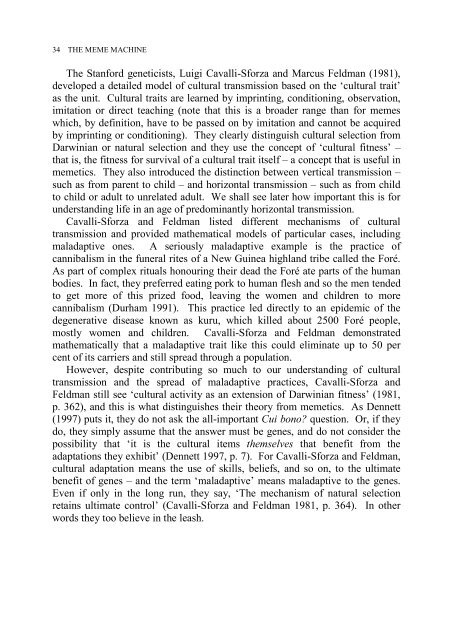The Meme Machine
TheMemeMachine1999
TheMemeMachine1999
- No tags were found...
Create successful ePaper yourself
Turn your PDF publications into a flip-book with our unique Google optimized e-Paper software.
34 THE MEME MACHINE<br />
<strong>The</strong> Stanford geneticists, Luigi Cavalli-Sforza and Marcus Feldman (1981),<br />
developed a detailed model of cultural transmission based on the ‘cultural trait’<br />
as the unit. Cultural traits are learned by imprinting, conditioning, observation,<br />
imitation or direct teaching (note that this is a broader range than for memes<br />
which, by definition, have to be passed on by imitation and cannot be acquired<br />
by imprinting or conditioning). <strong>The</strong>y clearly distinguish cultural selection from<br />
Darwinian or natural selection and they use the concept of ‘cultural fitness’ –<br />
that is, the fitness for survival of a cultural trait itself – a concept that is useful in<br />
memetics. <strong>The</strong>y also introduced the distinction between vertical transmission –<br />
such as from parent to child – and horizontal transmission – such as from child<br />
to child or adult to unrelated adult. We shall see later how important this is for<br />
understanding life in an age of predominantly horizontal transmission.<br />
Cavalli-Sforza and Feldman listed different mechanisms of cultural<br />
transmission and provided mathematical models of particular cases, including<br />
maladaptive ones. A seriously maladaptive example is the practice of<br />
cannibalism in the funeral rites of a New Guinea highland tribe called the Foré.<br />
As part of complex rituals honouring their dead the Foré ate parts of the human<br />
bodies. In fact, they preferred eating pork to human flesh and so the men tended<br />
to get more of this prized food, leaving the women and children to more<br />
cannibalism (Durham 1991). This practice led directly to an epidemic of the<br />
degenerative disease known as kuru, which killed about 2500 Foré people,<br />
mostly women and children. Cavalli-Sforza and Feldman demonstrated<br />
mathematically that a maladaptive trait like this could eliminate up to 50 per<br />
cent of its carriers and still spread through a population.<br />
However, despite contributing so much to our understanding of cultural<br />
transmission and the spread of maladaptive practices, Cavalli-Sforza and<br />
Feldman still see ‘cultural activity as an extension of Darwinian fitness’ (1981,<br />
p. 362), and this is what distinguishes their theory from memetics. As Dennett<br />
(1997) puts it, they do not ask the all-important Cui bono? question. Or, if they<br />
do, they simply assume that the answer must be genes, and do not consider the<br />
possibility that ‘it is the cultural items themselves that benefit from the<br />
adaptations they exhibit’ (Dennett 1997, p. 7). For Cavalli-Sforza and Feldman,<br />
cultural adaptation means the use of skills, beliefs, and so on, to the ultimate<br />
benefit of genes – and the term ‘maladaptive’ means maladaptive to the genes.<br />
Even if only in the long run, they say, ‘<strong>The</strong> mechanism of natural selection<br />
retains ultimate control’ (Cavalli-Sforza and Feldman 1981, p. 364). In other<br />
words they too believe in the leash.



